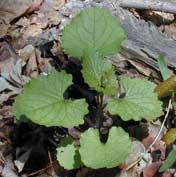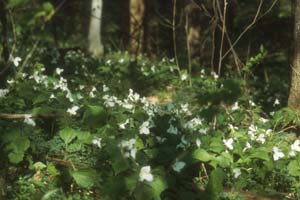Frequently Asked Questions (FAQ)
- What is the correct name for this plant?
- How can I identify garlic mustard?
- Where does it come from and where is it now?
- How did it get to Michigan?
- Why is the garlic mustard a problem?
- How can I control garlic mustard on my property?
- How can I report garlic mustard infestations?
- Is biological control of garlic mustard on option?
1. What is the correct name for this plant?
Garlic mustard is known by its scientific name, Alliaria petiolata, and is a member of the mustard family (Brassicaceae). This plant is known by several common names, most of which refer to its garlic-like scent and historic use as a cooking herb. "Garlic mustard" is the most widely used common name in North America. Other common names include garlic root, garlicwort, hedge-garlic, jack-by-the-hedge, jack-in-the-bush, mustard root, poor-man's-mustard, and sauce-alone. Older scientific names used in old collections include Alliaria alliaria, Sisymbrium alliaria, Sisymbrium officinalis, Erysimum alliaria, and in North America, Alliaria officinalis.
2. How can I identify garlic mustard? Garlic mustard has a two-year life cycle and appears different in its first and second years of growth. Its young leaves produce a garlic smell when crushed. As leaves mature, this odor fades. In its first year, garlic mustard produces rosettes of dark-purple to green, kidney-shaped leaves with scalloped edges (see photo at right). Second year plants grow rapidly from the rosette stage to about waist height and produce more or less triangular-shaped leaves with sharply toothed edges. Clusters of small white flowers grow at the top of each stem and slender green fruits, called siliques, radiate outward along the stem below the flowers. Individual plants can have multiple flowering stalks and the number of flowers and siliques varies greatly from plant to plant and stem to stem. Flowers each have four white petals that taper toward the base and six stamens, two long and four short. For more details, see About garlic mustard.
Garlic mustard has a two-year life cycle and appears different in its first and second years of growth. Its young leaves produce a garlic smell when crushed. As leaves mature, this odor fades. In its first year, garlic mustard produces rosettes of dark-purple to green, kidney-shaped leaves with scalloped edges (see photo at right). Second year plants grow rapidly from the rosette stage to about waist height and produce more or less triangular-shaped leaves with sharply toothed edges. Clusters of small white flowers grow at the top of each stem and slender green fruits, called siliques, radiate outward along the stem below the flowers. Individual plants can have multiple flowering stalks and the number of flowers and siliques varies greatly from plant to plant and stem to stem. Flowers each have four white petals that taper toward the base and six stamens, two long and four short. For more details, see About garlic mustard.
3. Where does garlic mustard come from and where is it now?
Garlic mustard is native to Europe and is found from England east to Czechoslovakia and from Sweden and Germany south to Italy. It has spread from its original range and is now found in North Africa, India, Sri Lanka, New Zealand, Canada and the United States. As of 2000, garlic mustard was present in 34 states and 4 Canadian provinces. Within the U.S., the largest populations are in New England and the Midwest.
4. How did it get to Michigan?
Garlic mustard may have been brought to North America for use as a cooking herb, although it is also possible that seeds were accidentally introduced from Europe. The first record of garlic mustard in the United States is from Long Island, NY, in 1868. Since then, humans and animals have spread it across North America. By 1991 it was found growing in 30 U.S. states and three Canadian provinces. Garlic mustard produces large numbers of seeds that can be transported by humans on boots, clothing, hair, by mowing, in automobiles and trains. Birds, rodents and whitetail deer are likely seed dispersers in woodland habitats.
5. Why is garlic mustard considered a problem?
Garlic mustard is one of the few non-native herbs capable of invading and dominating forest understory communities. Its tolerance of low light levels, coupled with its high seed production and ability to spread rapidly, make garlic mustard a strong competitor. It diverts resources from native spring woodland ephemeral plants such as liverworts, toothworts, solomon-seal, trilliums, trout lilly, sweet-cisley and many others. Because it begins growing very early in the spring, garlic mustard has a head start on other flowering plants and tree seedlings.

Native woodland flowers like these Trillium are in danger of being crowded out by garlic mustard.
Photo credits for this page: Douglas A. Landis
It readily invades forested habitats where it can displace native plants, compete with timber species regeneration, alter soil composition and structure, impact natural associations between plants and fungi, and result in cascading ecosystem impacts.
In Europe, garlic mustard is a host plant for cucumber mosaic virus (CMV), turnip mosaic virus (TMV), and turnip yellow mosic virus (TYMV-A), which affect commercial crucifer (mustard family) crops. On the noxious weed list in several states, the presence of garlic mustard as seed or rosettes in container or field grown nursery stock may result in rejection of plant materials or import restrictions. The harvest or commercial production of forest plants or fungi such as ginseng or morel mushrooms may also be affected.
6. How can I control the garlic mustard on my property?
Cutting, pulling, burning, and applying herbicides have all been used to control garlic mustard with varying degrees of success. For more details on how to employ these methods, please see the web page on management options.
7. NEW: How can I report garlic mustard infestations?
Garlic mustard infestations can be reported through the Midwest Invasive Species Information Network.
8. Is biological control of garlic mustard an option?
Using one organism to control another organism is called biological control. Current research efforts are underway to identify insects in Europe that feed on garlic mustard. If suitable species are found they could be imported and released to control infestations in the United States. For more information on this project please see the biological control section of the web page on management options.
Information prepared by: Doug Landis, Jeff Evans, Department of Entomology, Michigan State University. Funding support: Michigan Department of Agriculture and Rural Development – Pesticide and Plant Pest Management Division, AgBioResearch, and MSU Extension.



 Print
Print Email
Email